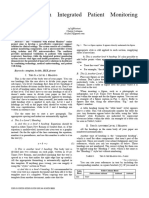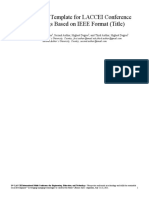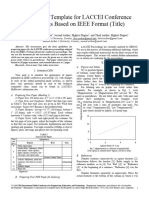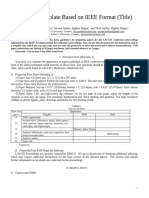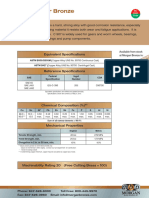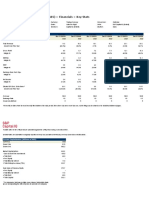0 ratings0% found this document useful (0 votes)
2 viewsIEEE-paper-format-template
IEEE-paper-format-template
Uploaded by
Yeoj BongonCopyright:
© All Rights Reserved
Available Formats
Download as PDF, TXT or read online from Scribd
IEEE-paper-format-template
IEEE-paper-format-template
Uploaded by
Yeoj Bongon0 ratings0% found this document useful (0 votes)
2 views2 pagesCopyright
© © All Rights Reserved
Available Formats
PDF, TXT or read online from Scribd
Share this document
Did you find this document useful?
Is this content inappropriate?
Copyright:
© All Rights Reserved
Available Formats
Download as PDF, TXT or read online from Scribd
Download as pdf or txt
0 ratings0% found this document useful (0 votes)
2 views2 pagesIEEE-paper-format-template
IEEE-paper-format-template
Uploaded by
Yeoj BongonCopyright:
© All Rights Reserved
Available Formats
Download as PDF, TXT or read online from Scribd
Download as pdf or txt
You are on page 1of 2
Paper Title
Given Name Surname
dept. name of organization
(of Affiliation)
name of organization
(of Affiliation)
City, Country
email address or ORCID
Abstract—IEEE format requires you to include an abstract
It’s recommended to insert figures inside a text box. So
at the start of your paper, followed by a list of keywords. In the
your figure would go here (adjusting the text box to the
“Styles” section in Microsoft Word, you can find the
appropriate styles for all the different sections and headings in
appropriate size to match).
the paper, which are already applied here. For example, the Fig. 1. This is a figure caption. It appears directly underneath the figure.
“abstract” style is applied to this text, the “keywords” style to
the next section. Note that the titles “Abstract” and “Keyword” appropriate style is still applied to each section, reapplying
should remain as they are written here: italicized and followed styles if necessary.
by an em dash.
b) This is another level 4 heading: It’s also possible to
Keywords—template, Scribbr, IEEE, format add bullet points when appropriate, using the “bullet list”
style:
I. THIS IS A LEVEL 1 HEADING
Treat the word “data” as plural, not singular.
This is the start of the body text of your paper. You can
use headings like the one above to divide your paper into sub- For example, “the data indicate that …”
topics. Use level 1 headings first, then level 2 headings if you
need further divisions inside those, and so on. Don’t use a B. This Is Another Level 2 Heading
level of heading unless there will be at least two headings of Place any figures or tables you use at the top or bottom of
that level. You don’t have to use any headings at all if it a column. Don’t place them in the middle of a column. If
doesn’t make sense to divide your paper in that way. particularly wide, a table or figure can span across both
Appropriate numbering is automatically applied to headings. columns. Insert a table or figure after the point where it is first
You don’t have to number them yourself, just make sure the cited in the text.
right heading style is applied to each one. Level 1 and 2 When inserting a figure, such as a photograph or
headings (as well as the paper title) should be written with title infographic, use 8 pt. Times New Roman for any labeling text
case capitalization, while level 3 and 4 headings are written in within the image and for the figure caption. You can see an
sentence case. example of a figure caption in Fig. 1, above. Refer to figures
Use the enter key to start a new paragraph. The appropriate like that, using the abbreviation “Fig.” and the figure’s
spacing and indent are automatically applied. number.
A. This Is a Level 2 Heading A table heading (using the “table head” style) appears
above a table. This will automatically number the table for
1) And this is a level 3 heading: Equations should be
you. Any footnotes appear below the table, using the “table
typed in either Times New Roman or Symbol font, or, if the footnote” style. Footnotes are indicated by superscript
equation is multileveled, inserted into your text as a graphic lowercase letters within the table. An example of a table can
instead. On the far right of the line containing the equation, be seen in Table I, below.
number it in parentheses, and use this number to refer to it in
the text (1). II. THIS IS ANOTHER LEVEL 1 HEADING
All the headings in the main body of your paper are
ab numbered (automatically).
Another type of heading is the “component heading”,
2) This is another level 3 heading: The body text is which is used for other components that aren’t part of the
divided into two columns on each page, written in 10 pt. main text. These are usually your acknowledgments and your
Times New Roman, and justified (meaning that the text is references, which you can see examples of below. These
spaced in a way that makes the right edge line up neatly). All headings are not numbered. The correct styling for them can
the appropriate formatting is automatically applied in this be applied using the “Heading 5” style, which is the same as
template. If anything goes wrong, you can reapply it using the the “Heading 1” style but without numbering.
“styles” section in Word.
TABLE I. THIS IS THE HEADING FOR A TABLE
a) And this is a level 4 heading: It’s recommended to
Table Table Column Head
write your text in a separate document and then add it to this
Head Table column subhead Subhead Subhead
template once it’s complete. When copying text into the
template from another document, make sure that the text Texta
a. This is a table footnote.
XXX-X-XXXX-XXXX-X/XX/$XX.00 ©20XX IEEE
You can cite your references in text by including the REFERENCES
corresponding number, in square brackets [1]. If you need to [1] D. V. Lindberg and H. K. H. Lee, “Optimization under constraints by
cite a specific part of the source, you can include a page applying an asymmetric entropy measure,” J. Comput. Graph. Statist.,
number [2, p. 13] or range [3, pp. 41–56]. vol. 24, no. 2, pp. 379–393, Jun. 2015, doi:
10.1080/10618600.2014.901225.
ACKNOWLEDGMENTS [2] B. Rieder, Engines of Order: A Mechanology of Algorithmic
Techniques. Amsterdam, Netherlands: Amsterdam Univ. Press, 2020.
“Acknowledgment(s)” is spelled without an “e” after the
[3] I. Boglaev, “A numerical method for solving nonlinear integro-
“g” in American English. differential equations of Fredholm type,” J. Comput. Math., vol. 34, no.
As you can see, the formatting ensures that the text ends in 3, pp. 262–284, May 2016, doi: 10.4208/jcm.1512-m2015-0241.
two equal-sized columns rather than only displaying one
column on the last page. Make sure to remove all placeholder and explanatory
This template was adapted from those provided by the text from the template when you add your own text.
IEEE on their own website. This text should not be here in the final version!
You might also like
- Peter G. Stein - Regulae Iuris - From Juristic Rules To Legal Maxims-Edinburgh University Press (1966)Document217 pagesPeter G. Stein - Regulae Iuris - From Juristic Rules To Legal Maxims-Edinburgh University Press (1966)Bruno A.100% (1)
- Cessna C172 Service & Repair Manual - 1977-85Document663 pagesCessna C172 Service & Repair Manual - 1977-85jwzumwalt100% (9)
- IEEE Template in US Letter Page SizeDocument4 pagesIEEE Template in US Letter Page SizeEdwinDuranJr.100% (1)
- SAP Manuscript TemplateDocument4 pagesSAP Manuscript Templaterakshit123No ratings yet
- Q1. Distinguish Between Instantaneous, Natural and Flat-Top Sampling. Show DiagrammaticallyDocument6 pagesQ1. Distinguish Between Instantaneous, Natural and Flat-Top Sampling. Show DiagrammaticallyAnjali BishtNo ratings yet
- EBM Assignment: Analysis of Business Models & Revenue Models of Shopper's StopDocument6 pagesEBM Assignment: Analysis of Business Models & Revenue Models of Shopper's StopBro SlowNo ratings yet
- IEEE Paper Format TemplateDocument2 pagesIEEE Paper Format Templatezain.shariff.redmiNo ratings yet
- IEEE Paper Format TemplateDocument2 pagesIEEE Paper Format TemplateSHIV PANDEYNo ratings yet
- IEEE Paper Format TemplateDocument2 pagesIEEE Paper Format Templatejorayan214No ratings yet
- IEEE FormatDocument4 pagesIEEE FormatPralhad AdhikariNo ratings yet
- IEEE Paper Format TemplateDocument2 pagesIEEE Paper Format Templatexisase6374No ratings yet
- IEEE Paper Format TemplateDocument2 pagesIEEE Paper Format Templatecargha440No ratings yet
- IEEE Paper Format TemplateDocument2 pagesIEEE Paper Format Templatempr gamingNo ratings yet
- ICTIS Paper-Format-TemplateDocument3 pagesICTIS Paper-Format-TemplateNisAr AhmadNo ratings yet
- IEEE Paper Format TemplateDocument2 pagesIEEE Paper Format Templatealijiha23No ratings yet
- IEEE Paper Format TemplateDocument2 pagesIEEE Paper Format TemplateRijul SaxenaNo ratings yet
- IEEE Paper Format TemplateDocument2 pagesIEEE Paper Format TemplateMithun GamingNo ratings yet
- Two-Column Template For Conference Proceedings Based On IEEE Format (Title)Document3 pagesTwo-Column Template For Conference Proceedings Based On IEEE Format (Title)Joseph LlanqueNo ratings yet
- 1 Conference Template A4 2023 Two Authors Different AffiliationsDocument4 pages1 Conference Template A4 2023 Two Authors Different AffiliationsPacy MugishoNo ratings yet
- My Journal: Muhammad Putra Senja KaimanaDocument3 pagesMy Journal: Muhammad Putra Senja Kaimana10Muhammad Putra SenjaNo ratings yet
- Two-Column Template For LACCEI Conference Proceedings Based On IEEE Format (Title)Document3 pagesTwo-Column Template For LACCEI Conference Proceedings Based On IEEE Format (Title)JesusChumbipumaNo ratings yet
- MATTER Template AddedDocument4 pagesMATTER Template Addedbuketpelin250No ratings yet
- Mari OthDocument6 pagesMari OthAbdullahWagimanNo ratings yet
- Formato de Proyectos 2019Document3 pagesFormato de Proyectos 2019Marco Joaquin Guaigua BucheliNo ratings yet
- Template2023 FullPapersDocument3 pagesTemplate2023 FullPapersJosé Alberto Ramires floresNo ratings yet
- TURJ Template (En)Document3 pagesTURJ Template (En)abood taiziNo ratings yet
- Research-Manuscript-Template of 2nd JournalDocument5 pagesResearch-Manuscript-Template of 2nd Journalvignanvijji2024No ratings yet
- Template IJSCET-OTH-1Document6 pagesTemplate IJSCET-OTH-1Andrea Santillan YzazagaNo ratings yet
- LEIRDTemplate2024-Before_Peer_Review_EELCLDDocument3 pagesLEIRDTemplate2024-Before_Peer_Review_EELCLDJose VelizNo ratings yet
- Template IJSCET-OTHDocument6 pagesTemplate IJSCET-OTHAlejandroNo ratings yet
- Paper FormatDocument5 pagesPaper FormatRudy surya 08No ratings yet
- 16th ERDT Conference Abstract TemplateDocument2 pages16th ERDT Conference Abstract TemplateLaurence AlmogueraNo ratings yet
- Paper Title (Use Style: Paper Title) : Subtitle As NeededDocument3 pagesPaper Title (Use Style: Paper Title) : Subtitle As Neededraj sharmaNo ratings yet
- Title: Concise and Informative, Avoid Abbreviations and Formulae Where PossibleDocument4 pagesTitle: Concise and Informative, Avoid Abbreviations and Formulae Where Possiblemahendra sutharNo ratings yet
- Conference Template A4 2023 SIX AUTHORSDocument4 pagesConference Template A4 2023 SIX AUTHORSPacy MugishoNo ratings yet
- Template_Report-UNTREF 2020Document3 pagesTemplate_Report-UNTREF 2020Tomas DiazNo ratings yet
- Formato LACCEI para Papers - TegucigalpaDocument3 pagesFormato LACCEI para Papers - TegucigalpaEdwin O. LagosNo ratings yet
- Paper ModeloDocument2 pagesPaper ModeloGuillermo LlamojaNo ratings yet
- Paper TemplateDocument3 pagesPaper TemplateALEXANDER PAUL HURTADO LOPEZNo ratings yet
- Paper Title: Authors Name/s Associated With 1st Affiliation Authors Name/s Associated With 2nd AffiliationDocument2 pagesPaper Title: Authors Name/s Associated With 1st Affiliation Authors Name/s Associated With 2nd AffiliationAlders PalilingNo ratings yet
- Termodinamika Dalam Prinisip Fisika TemplateDocument3 pagesTermodinamika Dalam Prinisip Fisika TemplateivanmaulanabNo ratings yet
- Termodinamika_dalam_Prinisip_Fisika_Template_IndonesiaDocument3 pagesTermodinamika_dalam_Prinisip_Fisika_Template_IndonesiaivanmaulanabNo ratings yet
- Ieee Paper GuidelinesDocument4 pagesIeee Paper Guidelineskannan2030No ratings yet
- Presettings:: General Paper FormatDocument4 pagesPresettings:: General Paper FormatArundhathi NNo ratings yet
- Tamplate JurnalDocument4 pagesTamplate Jurnalmuliadin_74426729No ratings yet
- FORMATO PAPER Template2022-LACCEIDocument3 pagesFORMATO PAPER Template2022-LACCEIJhair ParedesNo ratings yet
- Guideline Full Paper Template 18 Juni 2024Document5 pagesGuideline Full Paper Template 18 Juni 2024zaimNo ratings yet
- DigestTemplate IEMDC2021Document5 pagesDigestTemplate IEMDC2021k3975122No ratings yet
- MUCET2023 TemplateDocument5 pagesMUCET2023 TemplateJunnNo ratings yet
- IJSRCSEIT Paper Template A4Document3 pagesIJSRCSEIT Paper Template A4Harshit KansalNo ratings yet
- ISI TemplateDocument4 pagesISI TemplatejaiNo ratings yet
- Template Paper For U Ip Health MedDocument3 pagesTemplate Paper For U Ip Health MedPutriNo ratings yet
- European Journal of Electrical Engineering: Received: AcceptedDocument4 pagesEuropean Journal of Electrical Engineering: Received: AcceptedaneethavilsNo ratings yet
- TemplateDocument5 pagesTemplateSaška Sekulić PušicaNo ratings yet
- RIA TemplateDocument4 pagesRIA TemplatealumniPBA iainbatusangkarNo ratings yet
- Template ReviewDocument3 pagesTemplate ReviewSUSANA JIMENA TANANTA LEYVANo ratings yet
- EXTENDED ABSTRACT - PAPER TITLE (Use Style: Paper Title)Document2 pagesEXTENDED ABSTRACT - PAPER TITLE (Use Style: Paper Title)kamblezunjarNo ratings yet
- Template Oj-TP-OTH-1Document6 pagesTemplate Oj-TP-OTH-1Yousup AliNo ratings yet
- International Journal of Heat and Technology: Received: AcceptedDocument4 pagesInternational Journal of Heat and Technology: Received: AcceptedRoy UttomNo ratings yet
- Article Title Here in Title Case (Alt+A)Document3 pagesArticle Title Here in Title Case (Alt+A)aNo ratings yet
- My Published ArticleDocument4 pagesMy Published ArticleSandeep MathariyaNo ratings yet
- Two-Column Template For LACCEI Conference Proceedings Based On IEEE Format (Title)Document2 pagesTwo-Column Template For LACCEI Conference Proceedings Based On IEEE Format (Title)Jimmy Jhon Fernandez ZavaletaNo ratings yet
- IJSRET - Paper TemplateDocument3 pagesIJSRET - Paper TemplateYadav AkhileshNo ratings yet
- ODEH DataDocument7 pagesODEH DataAnonymusJVMDDDDNo ratings yet
- Catalogo LP DicDocument11 pagesCatalogo LP DicjhohanstevenstNo ratings yet
- Food Additive Status List - FDADocument91 pagesFood Additive Status List - FDABirdie ScottNo ratings yet
- c907 Gear BronzeDocument2 pagesc907 Gear BronzeMartin JensenNo ratings yet
- Straco Corporation Limited SGX S85 FinancialsDocument80 pagesStraco Corporation Limited SGX S85 FinancialsP.RaviNo ratings yet
- Exam Hall Seating Arrangement System Using PHP: © 2014 IJIRT - Volume 1 Issue 11 - ISSN: 2349-6002Document4 pagesExam Hall Seating Arrangement System Using PHP: © 2014 IJIRT - Volume 1 Issue 11 - ISSN: 2349-6002Ty DxlifeNo ratings yet
- LAMAGNA, Rose Solangon Re: Appointment University President Age Limit Query X - X Resolution NoDocument4 pagesLAMAGNA, Rose Solangon Re: Appointment University President Age Limit Query X - X Resolution NoMaria roxanne HernandezNo ratings yet
- MS Word Chapter 2Document18 pagesMS Word Chapter 2Shahwaiz Bin Imran BajwaNo ratings yet
- 06 ScaffoldingDocument4 pages06 ScaffoldingRosli Bin Abdul ShukorNo ratings yet
- Modeling Stock Return Distributions With A Quantum Harmonic OscillatorDocument13 pagesModeling Stock Return Distributions With A Quantum Harmonic OscillatorMusical RabbitNo ratings yet
- 48 60Document5 pages48 60j1931ppNo ratings yet
- Olivem 1000: The First Emulsifying IngredientDocument2 pagesOlivem 1000: The First Emulsifying IngredientAllergic Center100% (1)
- A Study On Study Habits and Academic Performance oDocument8 pagesA Study On Study Habits and Academic Performance oMagelyn OrganoNo ratings yet
- Periodic Classification of Elements: Textbook ExercisesDocument8 pagesPeriodic Classification of Elements: Textbook ExercisesRamyaNo ratings yet
- ACYFMG2 Quiz 2 QuestionsDocument41 pagesACYFMG2 Quiz 2 QuestionsArnold BernasNo ratings yet
- Gis Instrument Transformers EngDocument4 pagesGis Instrument Transformers EngCarlos CarreraNo ratings yet
- Chapter OneDocument9 pagesChapter OneMmaNo ratings yet
- Numerical Methods Test 1Document17 pagesNumerical Methods Test 1Ashley StraubNo ratings yet
- Format Penulisan Artikel IslamiyyatDocument2 pagesFormat Penulisan Artikel IslamiyyatTransformasi PMNo ratings yet
- Download Consciousness Demystified Todd E Feinberg ebook All Chapters PDFDocument60 pagesDownload Consciousness Demystified Todd E Feinberg ebook All Chapters PDFguaramehar42100% (4)
- Precipath HDL - LDL-C.11818171001.V10.en PDFDocument2 pagesPrecipath HDL - LDL-C.11818171001.V10.en PDFARIF AHAMMED PNo ratings yet
- Porcine Dna Detection in Finished Meat Products Using Different Mitochondrial Dna Mtdna On Polymerase Chain Reaction 2155 9600.1000323 4Document3 pagesPorcine Dna Detection in Finished Meat Products Using Different Mitochondrial Dna Mtdna On Polymerase Chain Reaction 2155 9600.1000323 4Muhammad ArifNo ratings yet
- The No Risk Pitch Method PDFDocument6 pagesThe No Risk Pitch Method PDFJuan IsaacNo ratings yet
- Body Management SkillsDocument4 pagesBody Management SkillsYe deeNo ratings yet
- Thorp Keep Calm and Carry OnDocument2 pagesThorp Keep Calm and Carry Ondmar5No ratings yet
- Beef Dashboard enDocument14 pagesBeef Dashboard enintspainNo ratings yet














